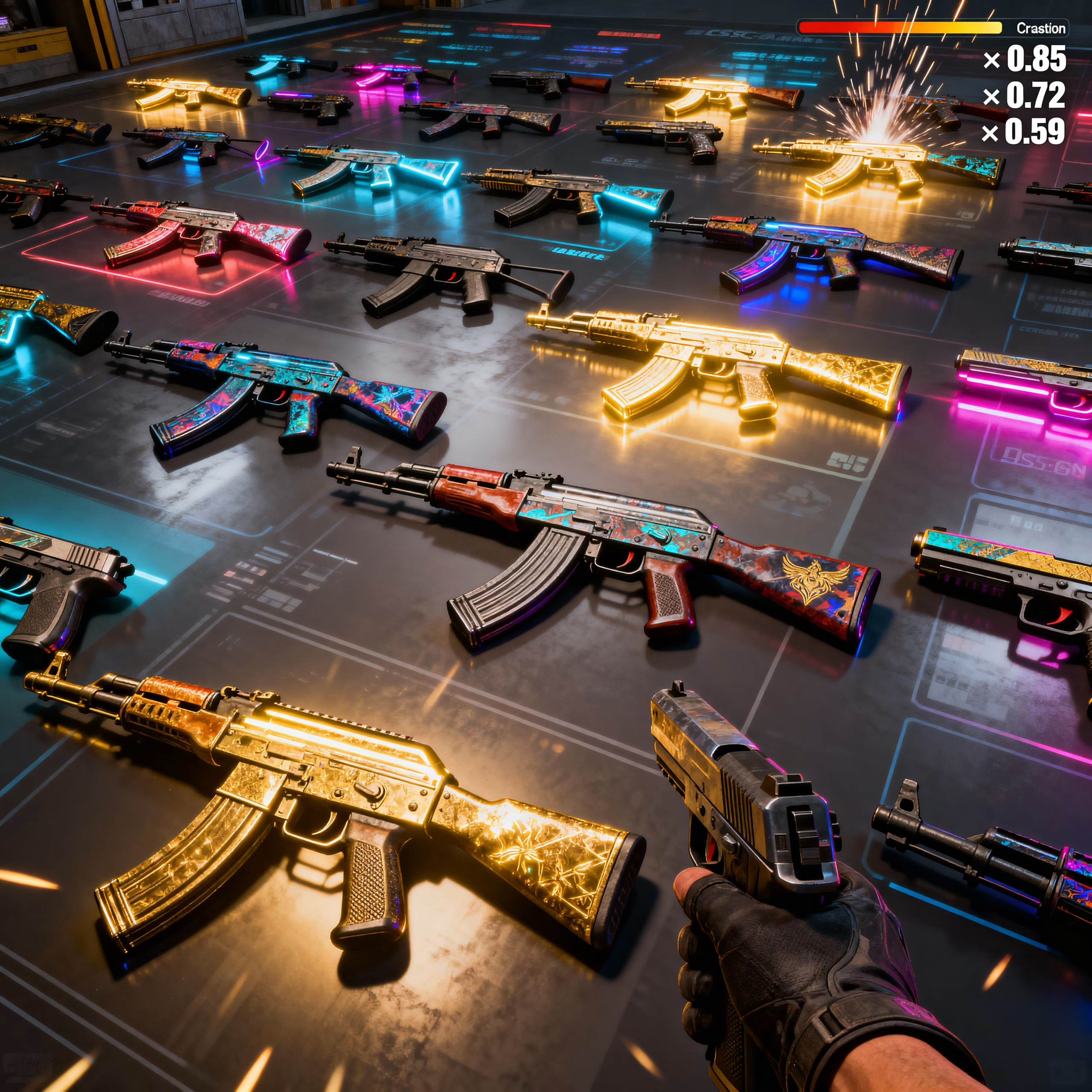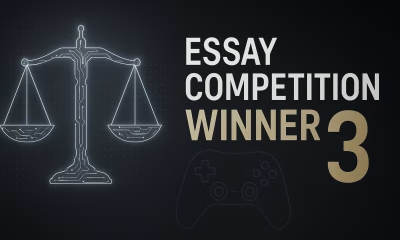Compliance & Regulatory
CS2’s Trade-Up Collapse No One Saw Coming

Table of Contents
Introduction
When Valve rolled out a Counter-Strike 2 update in late October 2025, most players expected nothing more than routine bug fixes and minor gameplay adjustments. Instead, the patch set off one of the fastest and most drastic market crashes the game has ever seen. The update quietly altered the mechanics of Trade Up Contracts, which is a system that allows players to exchange multiple lower-tier skins for a chance at a higher-tier cosmetic item.
Previously, the mechanics offered incremental upgrades with predictable outcomes, but the new patch suddenly allowed players to trade five Covert skins from the same collection for a guaranteed knife or gloves. This small input led to a crash that no gaming market has ever experienced so fast.Analysts estimated that the update wiped out an estimated $2 billion in market value.[1]
Knife prices fell sharply, collectors panicked, and both casual players and professional traders watched years of predictable market behaviour disappear in a matter of hours. This shift replaced rarity with a predictable pipeline, triggering a crash no gaming market had experienced. This update was a reminder that the systems behind in-game economies can shift suddenly, especially when new mechanics affect how rare items are traded on the market.
The Fallout for Players: Consumer Vulnerability After Destabilisation After Valve’s CS2 Update
For long-time collectors, the October 2025 update destroyed years of accumulated values. High-end knives and gloves[2]coveted trophies, dropped dramatically in price. The staple of CSGO has always been the butterfly knife skin which is a defining symbol of achievement in the game due to its rarity. Many of these players treated their skins as quasi-investments; the sudden revaluation left longstanding inventories deeply devalued. From a legal perspective, this raises concerns.
Although Valve’s Terms of Service and EULA grant it wide discretion to modify game mechanics, users had nonetheless formed reasonable expectations regarding rarity, drop mechanics, and the stability of the skin economy. These expectations were never contractually guaranteed, but the crash exposed how tenuous they were. Many professional players left the market entirely due to the shock and concern they felt for the future of the in game economy.
For newer or more casual users, the update looked like a windfall: trading five Covert skins to guarantee a gold-tier items created a pathway previously unavailable. No longer were players at the mercy of random case openings or high secondary market prices, but the predictability was deceptive. As newly crafted items flooded the market, a user could trade up ‘expensive’ Covert skins only to end up with a gold-tier output. This is worth less than the sum of their investments, which in practice, meant the predictability of the method did not guarantee a stable value.
The lack of transparency from Valve further deepened the risk. The update was buried in the patch notes, not framed as an economic reset, and Valve did not issue a public statement addressing the market-wide implications.[3] Many players felt blindsided. This disconnect between legal disclosure (ToS / patch notes) and practical consumer understanding has sparked intense debate. When value evaporates overnight, it’s not just a gameplay tweak: it’s a financial shock for those who built up large inventories.
Hence, this crash spotlighted a major consumer-protection problem. Many players, especially those new to the CS2 economy, had assumed that rare skins would retain or grow in value.[4] That assumption was partly driven by years of market inflation, content creators treating skins like investment assets, and a general sentiment in the community that rare skins were ‘safe’ stores of value. Hence, it exposed just how speculative and fragile that belief was. By failing to contextualise the economic risk, Valve shifted a huge portion of the downside onto players themselves.
Ultimately, the update raises serious questions about whether there should be structural safeguards for players in such a centrally controlled but economically meaningful digital economy. When a single design decision by Valve can wipe out billions in player-held value, is there a stronger case for transparency, pre-patch economic risk disclosures, or even regulation?[5]
Exposed Structural Weakness in the CS2 Economy: Governance, Scarcity and Systemic Failure
The core of the crash was straightforward: Valve’s update created a repeatable production pipeline for items that were previously defined by extreme scarcity. Before October 2025, knives and gloves were exceptionally rare, obtainable almost exclusively through case openings with ultra-law drop rates. The revised Trade-Up Contract bypassed that rarity altogether, effectively turning gold-tier items into manufacturable outputs rather than lucky drops.
The result was a sudden, massive surge in supply. High-volume traders immediately began mass-crafting; casual players followed; and within hours, the market was overwhelmed with newly created knives and gloves.[6] No ecosystem, digital or otherwise, can absorb that level of supply expansion without violent repricing.
Unlike traditional financial markets, however, the CS2 economy has no stabilising infrastructure. There are no circuit breakers to pause trading during extreme volatility, no listing freezes to slow panic behaviour, and no liquidity buffers to dampen shocks. Prices collapsed in minutes, not weeks.
Marketplaces were flooded with panicked delistings, automatic undercuts, and mass selloffs as traders scrambled to exit before values fell further. Reports from industry trackers show knives and gloves dropping within hours, with an estimated US$1.8 – 2.3 billion wiped from market capitalisation almost immediately.[7] What this revealed is that the CS2 economy is propped up entirely by soft norms of scarcity rather than any enforceable monetary policy or supply management.
Compounding the shock was the absence of prior warning or economic guidance from Valve. From a software-development standpoint, shipping patches without market commentary is routine. But from an economic-governance perspective, especially in a multi-billion-dollar marketplace, this silence created preventable chaos.[8] Marketplaces facilitate billions in transactions but operate without the stabilisation mechanisms common in regulated exchanges.
Players, the nearest thing this ecosystem has to shareholders, are left holding assets whose value can be rewritten without warning. Speculation from players believe that Valve did this intentionally in order to increase their control over the skin economy. This was thought to have led to increased marketplace revenue for them as it takes a percentage of sales from there instead of third-party websites.[9]
The October crash exposed a structural truth many overlooked: the CS2 economy is not merely a market within a game; it is a market entirely governed by the game’s designer. Without clearer oversight, protective mechanisms, or coordinated economic governance, it remains vulnerable to future shocks of similar magnitude.[10]
Post-Crash Market Dynamics and Recovery Pathways in CS2
There are early signs that the market could potentially rebound, but the overall risk landscape remains significantly elevated. As immediate panic subsided, opportunistic buyers and traders stepped in, and some high-liquidity items began to stabilise; market trackers reported a notable bounce after the steep initial drop, suggesting parts of the crash were partly an overcorrection driven by panic rather than a full structural revaluation.[11] However, recovery has been highly uneven: mainstream, liquid items have shown relative resilience while rarer, niche collector pieces remain lower due to thin order books and diminished buyer confidence.[12]
A major near-term vulnerability is the cooldown/lockup cycle on newly crafted gold items. Thousands of knives and gloves created through the Trade-up pathway are subject to trading restrictions and, as those cooldowns expire, many of those items will either be listed for sale or hoarded; either outcome creates fresh uncertainty. If a material share of the newly craftable items is listed when cooldowns lift, the additional supply could cause a second, more protracted downward leg in prices (a “second-wave” supply shock) rather than a quick rebound.[13]
The crash has a structural dimension: scarcity in CS2 was a designed property, not a natural one, and Valve’s update demonstrated how quickly design changes can rewrite value. That realisation is shifting marketing psychology: institutional traders and inventory funders are already recalibrating exposure, some reducing positions in ultra-high-end items and others diversifying to hedge against the future unilateral changes.[14] Even if prices recover nominally, the market’s psychological floor has likely shifted; traders now price in a non-trivial governance risk premium because future patches could again alter scarcity rules without notice.[15]
Finally, the crash highlights a governance gap: large digital marketplaces that host multi-billion-dollar economies typically rely on instruments such as circuit breakers, disclosure protocols, or pre-announcement windows to manage systemic risk. CS2’s ecosystem lacks those institutional stabilisers; Valve’s unilateral patching model and the limited toolkit available to third-party marketplaces (no marketplace-level trading halts, limited price stabilisation tools) amplified the shock and left players exposed.
The market’s future will depend less on short-term price rebounds and more on whether Valve’s platform operators implement clear communication, temporary volatility controls, or other structural safeguards to limit the systemic effects of economic updates.[16]
Conclusion
The October 2025 crash was more than a dramatic week in the CS2 marketplace. It serves as a reminder of how fragile digitally constructed economies can be. For years, players, traders, and collectors operated under the belief that rarity was stable, that prices reflected long-term demand, and that the ecosystem as, whole was volatile, predictable enough to feel secure. Valve’s update broke the sense of stability in a matter of hours.
The crash ultimately reveals not just a pricing problem, but a governance problem. When a single design choice can erase billions in value, the conversation naturally shifts from player strategy to platform responsibility. Digital economies are now large and meaningful enough that sudden rule changes can affect livelihoods, investments, and communities in ways that go far beyond ordinary gameplay.
Whether the market eventually recovers is only part of the story. The longer-lasting consequence is a shift in how players understand risk in an environment they do not control. Confidence may return, but certainty cannot. Unless Valve and the third-party marketplaces surrounding CS2 begin treating economic updates with the level of communication and stability expected in any high-value financial system, this will not be the last shock of its kind.
In the end, the crash was not simply a market event. It was a wake-up call. It reminded players that the value of their digital assets is only as stable as the decisions of the developers who shape their world, and that in a system built on code, scarcity can change at any moment.
[1] Ernestas Naprys, ‘Steam update sends Counter-Strike 2 skin market into disarray, wiping out $2B of value,’ (Cybernews, 2025)
https://cybernews.com/tech/cs2-update-sends-skin-prices-plummeting-wiping-billions/
[2] Aaron McKinley, ‘Counter-Strike 2 Update Has Obliterated the Skins Market,’ (GameRant, 2025) https://gamerant.com/counter-strike-2-skins-market-crash/
[3] Luca Moretti, ‘Valve’s knife/glove trade-ups spark CS2 skin-market turmoil; Retakes mode returns,’ (CS2 News, 2025) https://cs2news.com/news/valve-cs2-update-triggers-skin-market-crash-2025
[4] Harry Childs, ‘CS2 Skins Market Crashes: $2 Billion Vanishes as Valve Drops Game-Changing Update’ (Crunch Sports, 2025)
https://www.crunchsports.com/esports/cs2-skins-market-crashes-valve-update-2/
[5] Alex Panasenko, ‘CS2: The ‘Doomsday’ for the skin market arrives on October 30th,’ (GN Crypto, 2025)
https://www.gncrypto.news/news/cs2-skin-market-doomsday-october-30-crash
[6] Emile Laurent, ‘CS2 skin market sheds $1.8B after knife/glove crafting update,’ (CS2 News, 2025)
https://cs2news.com/news/cs2-skin-market-sheds-%24-1.8B-after-knife-glove-crafting-update
[7] James Lucas, ‘CS2 Knife Update Crashes Marketplace Value By $1.7 Billion,’ (The Gamer, 2025)
https://www.thegamer.com/counter-strike-2-cs2-knives-gloves-update-skin-market-cap-2-billion-dollar-loss
[8] Kerem Gülen, ‘CS2 trade update upends skin market with new knife crafting,’ (DataConomy, 2025)
https://dataconomy.com/2025/10/23/cs2-trade-update-upends-skin-market-with-new-knife-crafting/
[9] Mike Stubbs, ‘Valve Just Crashed The High End ‘Counter-Strike’ Skins Market,’ (Forbes, 2025) https://www.forbes.com/sites/mikestubbs/2025/10/23/valve-just-crashed-the-high-end-counter-strike-skins-market/
[10] Alex Panasenko, ‘CS2 Skin Market recovers after historic $2B crash,’ (GN Crypto, 2025) https://www.gncrypto.news/news/cs2-skin-market-recovery-after-valve-crash-2025/
[11] Hassam Nassir, ‘Ludicrous $6 billion Counter Strike 2 skins market crashes, loses $3 billion overnight — game update destroys inventories, collapses market,’ (Tom’s Hardware, 2025) https://www.tomshardware.com/video-games/ludicrous-usd6-billion-counter-strike-2-skins-market-crashes-loses-usd3-billion-overnight-game-update-destroys-inventories-collapses-market/
[12] Kyle Orland, ‘CS2 item market loses nearly $2B in value overnight due to ‘trade up’ update,’ (ARS Technica)
https://arstechnica.com/gaming/2025/10/valve-upends-the-cs2-item-marketplace-with-new-trade-up-update/
[13] Daryl Baxter, ‘How Valve’s Counter-Strike 2 patch has tanked the skin market,’ (Esports Insider, 2025)
https://esportsinsider.com/counter-strike-2-skin-update-explained
[14] Ibid (n.9)
[15] Eugene Bozhenko, ‘Valve breaks the skins market with trade-up contracts for CS2 knives,’ (Esports.gg, 2025)
https://esports.gg/news/counter-strike-2/knives-trade-up-contracts-cs2-update/
[16] Darragh Harbinson, ‘Counter-Strike skins crash has exposed the unspoken truth of the skins economy,’ (Esports News UK, 2025)
https://esports-news.co.uk/2025/10/24/counter-strike-skins-crash-has-exposed-the-unspoken-truth-of-the-skins-economy/
















